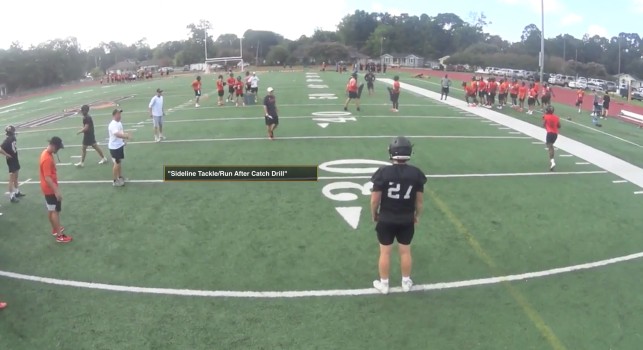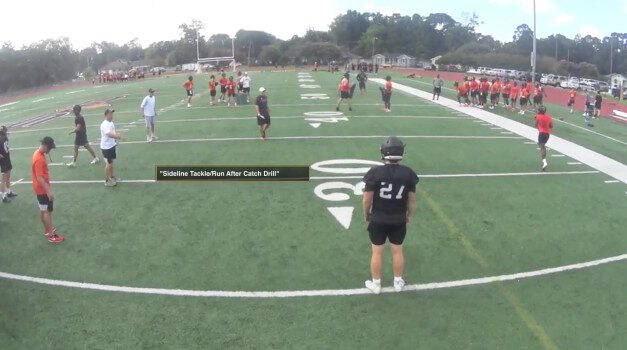Non-Contact Drill Work to Teach Tackling, Block Destruction and Ball Security
Head Coach
Catholic High School (LA)
Twitter: @fertitta_gabe
One of the most difficult things to teach football players at all levels, and probably receives the least instruction, is the fundamental of running with the football after the catch (or in open field on runs). Additionally, defenses are constantly looking for new ways to drill open field tackling without adding more contact to the game. Most states now have limits on the amount of contact time in practice, and coaches across the country are concerned about their ability to teach tackling without drills that use full contact techniques. In studying drills and film from places like the New England Patriots, Troy University, and West Virginia, we have come up with a few “Tackle/RAC” (run after catch) drills that we have incorporated into all seasons of our program development. These drills can be done any time, without pads, and without any contact. Additionally, if you were to review your own film, you would find these situations arise multiple times in a game and most practices do not have the time or structure in place to drill these situations.

Sideline Tackle/Run After Catch Drill:
Drill Setup:
The first drill we use in our Tackle/RAC circuit is set up with two shield holders, an offensive player, quarterback, and a defensive player. The beauty of these circuits is that in a short amount of time, you can work a ton of players through the drill and get vast amounts of reps. Additionally, if you have two-way players, this is an easy way to drill simple things like catching the ball with hands, getting vertical after the catch, approach to tackle, shimmy, and striking with the correct shoulder on defense.
This drill could be done with full contact; however, we always use this drill with a tag off on the hip of the ball carrier. We can track wins and losses through the drill by determining if the defender was in a position to make the tackle before the 10-yard mark.

Offensive Coaching Points for Sideline Tackle/RAC:
- Quarterbacks will PAT the ball to signal the start of the drill.
- Ball carriers will start on the sidelines and run to between the cones and receive the ball between the two shield holders.
- As soon as the ball is caught, the ball carrier must get vertical to split the shield holders, simulating getting vertical after a catch in space like a dig or slant.
- Only ONE cut or move is allowed from the ball carrier although if the defense has practiced this situation enough, the ball carrier will soon learn that he probably can’t win if he makes more than one move.
- The offense can “WIN” the dill by making it to the 10-yard mark from the catch. Boundaries for the ball carrier in this drill are the top of the numbers and sidelines.
Defensive Coaching Points for Sideline Tackle/RAC:
- The instant the defensive player in front of you does his “up/down,” get aligned and still on your cone at the top of the numbers. We like to use this pursuit angle to train the defense for inside out pursuit and using the sideline as an extra tackler.
- When the quarterback pats the ball to signal the start of the rep, the defensive player must execute an “up/down” and pop to his feet and begin to pursue the offensive player.
- The most critical coaching point for the defense is to tackle with the correct shoulder based on leverage and CLOSE THE SPACE between him and the ball carrier as fast as possible.
- Once the tackler has closed the space, he should then get into Mobile Athletic Position (MAC) and shimmy to lower his hips, get his cleats in the ground, and set up for a “near leg/near shoulder” strike.







